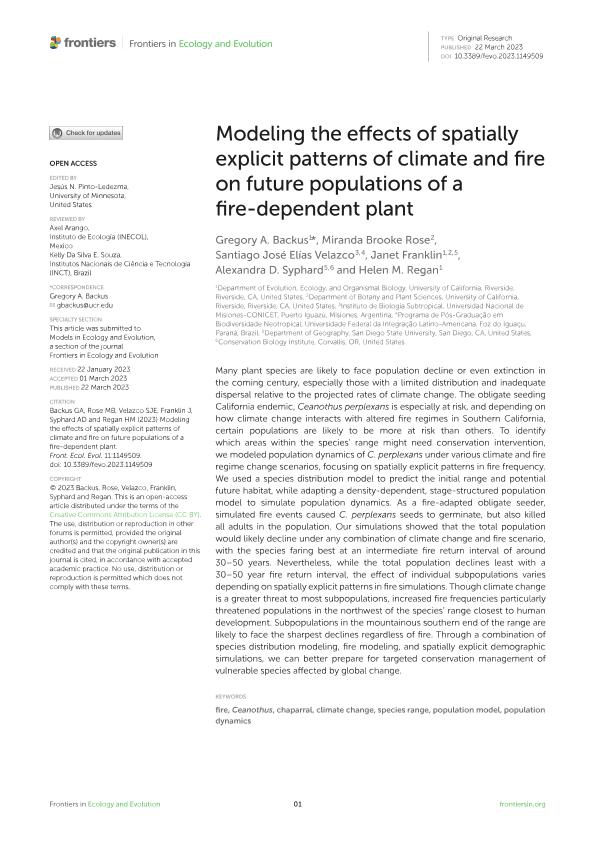Mostrar el registro sencillo del ítem
dc.contributor.author
Backus, Gregory A.
dc.contributor.author
Brooke Rose, Miranda
dc.contributor.author
Velazco, Santiago José Elías

dc.contributor.author
Franklin, Janet
dc.contributor.author
Syphard, Alexandra D.
dc.contributor.author
Regan, Helen M.
dc.date.available
2024-04-16T11:00:12Z
dc.date.issued
2023-03
dc.identifier.citation
Backus, Gregory A.; Brooke Rose, Miranda; Velazco, Santiago José Elías; Franklin, Janet; Syphard, Alexandra D.; et al.; Modeling the effects of spatially explicit patterns of climate and fire on future populations of a fire-dependent plant; Frontiers Media; Frontiers in Ecology and Evolution; 11; 3-2023; 1-12
dc.identifier.issn
2296-701X
dc.identifier.uri
http://hdl.handle.net/11336/233126
dc.description.abstract
Many plant species are likely to face population decline or even extinction in the coming century, especially those with a limited distribution and inadequate dispersal relative to the projected rates of climate change. The obligate seeding California endemic, Ceanothus perplexans is especially at risk, and depending on how climate change interacts with altered fire regimes in Southern California, certain populations are likely to be more at risk than others. To identify which areas within the species’ range might need conservation intervention, we modeled population dynamics of C. perplexans under various climate and fire regime change scenarios, focusing on spatially explicit patterns in fire frequency. We used a species distribution model to predict the initial range and potential future habitat, while adapting a density-dependent, stage-structured population model to simulate population dynamics. As a fire-adapted obligate seeder, simulated fire events caused C. perplexans seeds to germinate, but also killed all adults in the population. Our simulations showed that the total population would likely decline under any combination of climate change and fire scenario, with the species faring best at an intermediate fire return interval of around 30–50 years. Nevertheless, while the total population declines least with a 30–50 year fire return interval, the effect of individual subpopulations varies depending on spatially explicit patterns in fire simulations. Though climate change is a greater threat to most subpopulations, increased fire frequencies particularly threatened populations in the northwest of the species’ range closest to human development. Subpopulations in the mountainous southern end of the range are likely to face the sharpest declines regardless of fire. Through a combination of species distribution modeling, fire modeling, and spatially explicit demographic simulations, we can better prepare for targeted conservation management of vulnerable species affected by global change.
dc.format
application/pdf
dc.language.iso
eng
dc.publisher
Frontiers Media

dc.rights
info:eu-repo/semantics/openAccess
dc.rights.uri
https://creativecommons.org/licenses/by-nc-sa/2.5/ar/
dc.subject
fire
dc.subject
Ceanothus
dc.subject
chaparral
dc.subject
climate change
dc.subject
species range
dc.subject
population model
dc.subject
population dynamics
dc.subject.classification
Ecología

dc.subject.classification
Ciencias Biológicas

dc.subject.classification
CIENCIAS NATURALES Y EXACTAS

dc.title
Modeling the effects of spatially explicit patterns of climate and fire on future populations of a fire-dependent plant
dc.type
info:eu-repo/semantics/article
dc.type
info:ar-repo/semantics/artículo
dc.type
info:eu-repo/semantics/publishedVersion
dc.date.updated
2024-04-15T15:47:18Z
dc.journal.volume
11
dc.journal.pagination
1-12
dc.journal.pais
Suiza

dc.description.fil
Fil: Backus, Gregory A.. University of California; Estados Unidos
dc.description.fil
Fil: Brooke Rose, Miranda. University of California; Estados Unidos
dc.description.fil
Fil: Velazco, Santiago José Elías. Consejo Nacional de Investigaciones Científicas y Técnicas. Centro Científico Tecnológico Conicet - Nordeste. Instituto de Biología Subtropical. Instituto de Biología Subtropical - Nodo Puerto Iguazú | Universidad Nacional de Misiones. Instituto de Biología Subtropical. Instituto de Biología Subtropical - Nodo Puerto Iguazú; Argentina
dc.description.fil
Fil: Franklin, Janet. University of California; Estados Unidos
dc.description.fil
Fil: Syphard, Alexandra D.. San Diego State University; Estados Unidos
dc.description.fil
Fil: Regan, Helen M.. University of California; Estados Unidos
dc.journal.title
Frontiers in Ecology and Evolution
dc.relation.alternativeid
info:eu-repo/semantics/altIdentifier/url/https://www.frontiersin.org/articles/10.3389/fevo.2023.1149509/full
dc.relation.alternativeid
info:eu-repo/semantics/altIdentifier/doi/http://dx.doi.org/10.3389/fevo.2023.1149509
Archivos asociados
